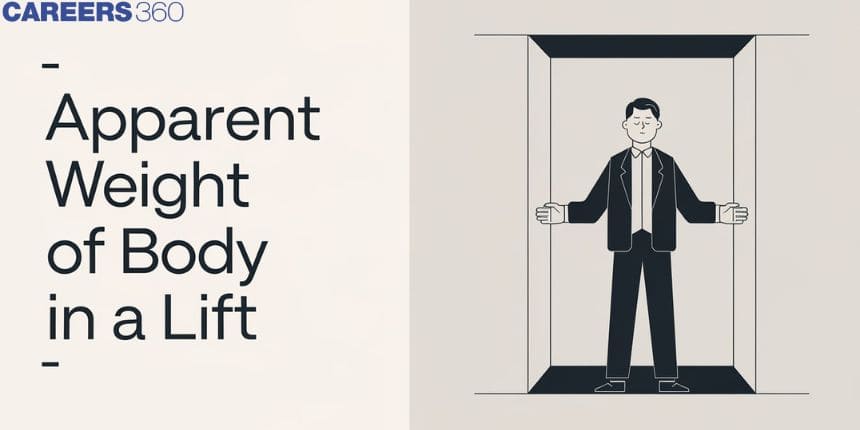Apparent Weight Of Body In A Lift
The real weight of a body of mass m in a lift is mg when the body is placed on a weighing machine. This has an impact on a weighing device, which, depending on its reading, generates a response R. The response generated by the body's point of contact is the perceived weight in the lift.
This Story also Contains
- Apparent Weight of Body in a Lift
- Lift is Moving Down at the Rate 'a > g'
- Solved Examples Based on Apparent Weight of Body in a Lift
- Summary

In this article, we will cover the concept of the apparent weight of the body in a Lift. This topic comes under the chapter of laws of motion, which is a crucial chapter in Class 11 physics. It is not only essential for board exams but also for competitive exams like the Joint Entrance Examination (JEE Main), National Eligibility Entrance Test (NEET), and other entrance exams such as SRMJEE, BITSAT, WBJEE, BCECE and more. Over the last ten years of the JEE Main exam (from 2013 to 2023), a total of two questions have been asked on this concept.
Let's read this entire article to gain an in-depth understanding of the apparent weight of the body in a lift.
Apparent Weight of Body in a Lift
There are two basic cases: one when the lift is accelerating down and one when the lift is accelerating up. Let's go over each one.
Lift Accelerating Down With 'a' (a<g)
V= variable
a<gmg−R=maR=m(g−a)
Apparent weight $<$ Actual weight
Lift is Moving Down With a = g
a=gmg−R=mgR=0
Apparent weight = 0 (weightlessness)
Lift is Moving Down at the Rate 'a > g'
V= Variable a>gmg−R=maR=−ve
The body will rise from the floor of the lift & stick to the ceiling of the lift.
Recommended Topic Video
Solved Examples Based on Apparent Weight of Body in a Lift
Example 1: A man standing in a lift carrying a bag of 5Kg. If the lift moves vertically upwards with acceleration g/2 then find tension (in Newton) force in the handle of the bag use (g=10 m/s2)
1) 75
2) 25
3) 50
4) 100
Solution:
Acceleration of the block, a=g2=5 m/s2massoftheblock,m=5kg
Let the tension in the string be T.
F.B.D of the block

U sing Fnet =maT−mg=ma⇒T=m(g+a)⇒T=5×(10+5)=75 N
Hence, the answer is option (1)
Example 2: A man weighs 80 Kg. He stands on a weighing machine in a lift which is going downwards with a uniform acceleration of 5 m/s2. What would be the reading of the machine? (reading in Newtons)
1) 400
2) 1200
3) 800
4) 100
Solution:
When Lift accelerating down with 'a' ()
So,
mg−R=maR=m(g−a)
i.e Apparent weight Actual weight
Draw FBD of man
R

mg−R=5mR=m(g−5)R=80∗5R=400N
Example 3: If a 5 Kg mass is suspended by a spring balance in a lift which is accelerated downward at 10 m/s 2 . The reading of the balance is
1) more than 5Kg weight
2) is less than 5Kg weight and greater than zero
3) is equal to 5 Kg weight
4) zero
Solution:
The apparent weight of the body in a lift when the Lift is moving down with a = g
As a=gmg−R=mgR=0
Apparent weight = 0 (weightlessness)
Draw FBD of block

mg−T=mgT=0
so reading of balance is zero
Hence, the answer is option (4).
Example 4: A lift is moving down with acceleration a. A man in the lift drops a ball inside the lift. The acceleration of the ball as observed by the man in the lift and a man standing stationary on the ground are respectively:
1) g,g
2) g−a,g−a
3) g−a,g
4) a,g
Solution:
As we learnt in
Lift accelerating down with 'a' -
V= variable
a<gmg−R=maR=m(g−a)
wherein
Apparent weight $<$ Actual weight
For the man standing in the lift, the acceleration of the ball.
abm→=ab→−am→⇒abm→=g−a
For the man standing on the ground, the acceleration of the ball.
abm→=ab→−am→⇒abm→=g−0=g
Hence, the answer is the option (3).
Example 5: A lift starts moving down with a constant acceleration 15 m/s2 . A coin initially is at rest on the floor of the lift. The height of the lift is 2.5 m. How much time (in seconds) will the coin take to touch the ceiling of the lift q=10 m/s2,
1) 1
2) 2
3) 3
4) 4
Solution:
Given,
Height of lift h=2.5 m, downward acceleration of the lift, al=15 m/s2
Since the acceleration of the lift is greater than the acceleration due to gravity and in the downward direction, the coin will lose contact with the floor of the lift immediately after the motion begins. The motion of the coin will be free fall under gravity.
Therefore, the acceleration of the coin- ac=g=10 m/s2
Acceleration of the lift with respect to coin-
alc=al−ac=15−10=5 m/s2
Displacement of lift with respect to the coin- slc=2.5 m
The initial velocity of lift with respect to coin, ulc=0
Applying the second equation of motion for uniformly accelerated motion-
slc=ulct+12alct2⇒2.5=0+12×5×t2⇒t=2×2.55=1 s
Hence, the answer is the option (1).
Summary
One feature that characterises an object's perceived weight is its apparent weight. Your apparent weight during a lift is one instance. The perceived weight shifts as the list gets longer because of a downward push. You will feel heavier when you walk on a scale in a lift that is moving quickly upward because the floor of the lift presses harder against your feet. You feel lighter on the other side when the lift descends.